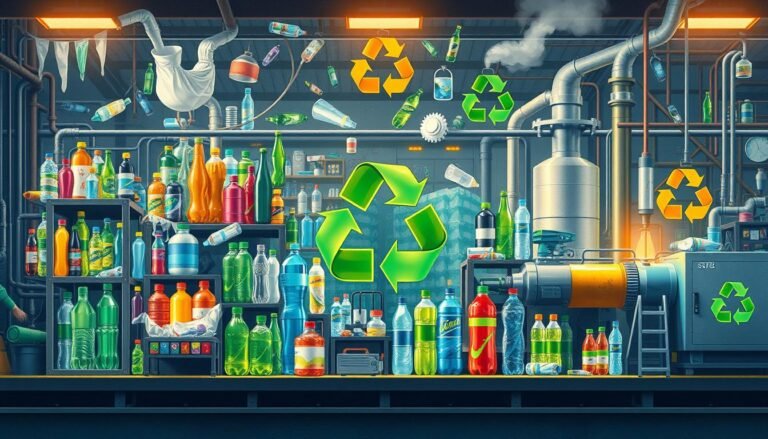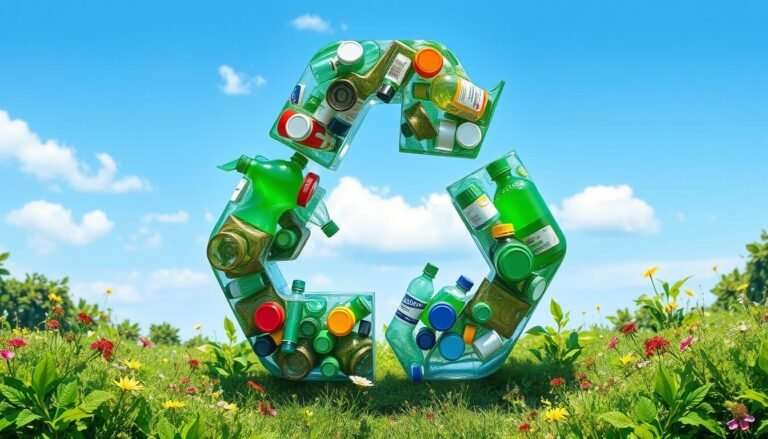Make some changes to the world environment
-
Building 3, Wanyang Innovation City, Langxia Street, Yuyao City, Zhejiang Province
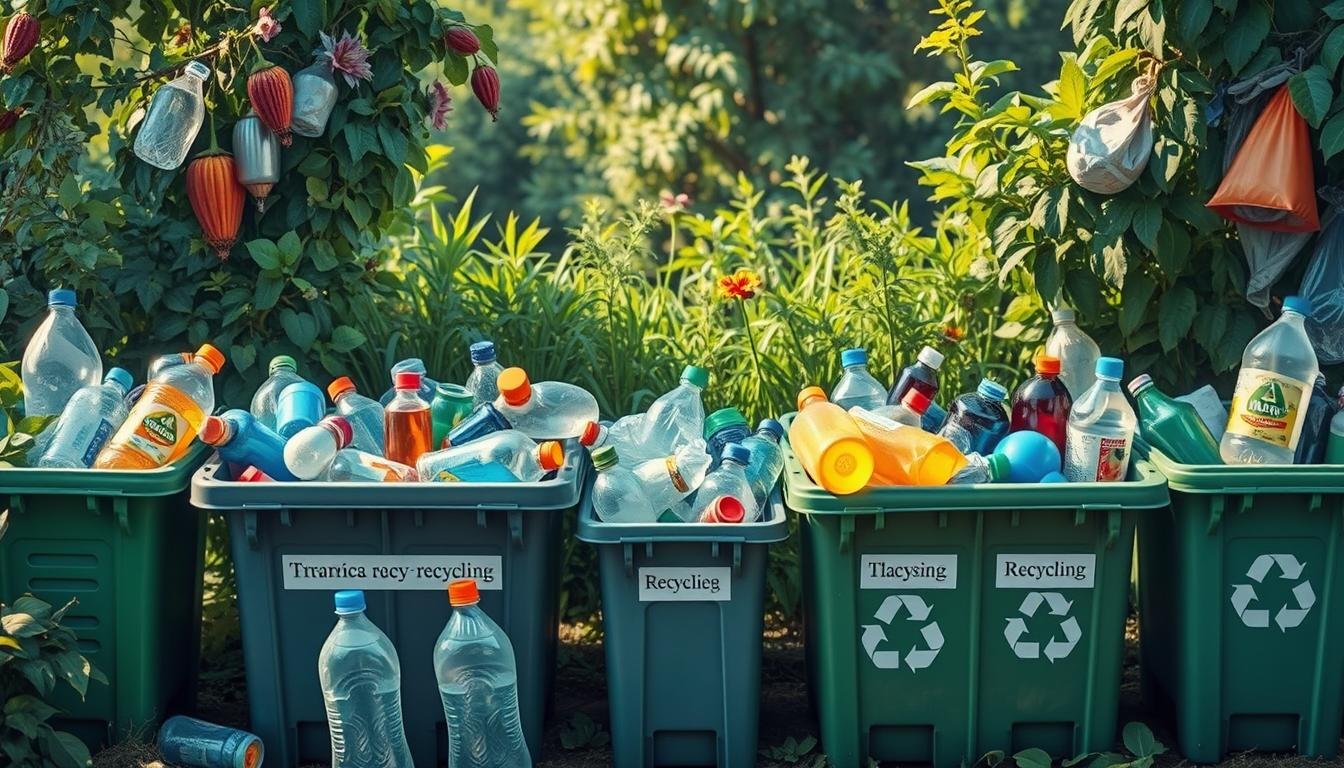
Guide to Recycle Plastic: Easy & Effective Methods
Have you ever wondered what happens to your plastic bottle after you recycle it? Does it get recycled, or does it end up in a landfill? Recycling plastic is complex and involves many steps and rules. By understanding this process, we can better protect the environment and manage our plastic waste. Let’s explore the proper ways to recycle plastic, including both common and new methods.
Key Takeaways
- The number of plastic products and waste is expected to triple by 2060, whereas the recycling rate will only see a slight increase1.
- In the United States, the recycling rate for plastics dropped from 9% in 2018 to 6% in 2021 due to a halt in plastic exports to China1.
- There are seven common types of plastics, each requiring different recycling techniques1.
- Understanding local recycling center guidelines is crucial for proper plastic waste management2.
- Only 9% of the plastic produced in the last 70 years has been recycled3.
- Innovative techniques, such as optical sorting and sink-float separation, enhance the efficiency of recycling2.
Understanding the Basics of Plastic Recycling
Plastic recycling is crucial in managing waste and helping our environment. It cuts down pollution and saves natural resources. Knowing how plastic recycling works shows us why it’s so important and beneficial.
What Happens to Plastic in the Recycling Bin
When we recycle plastic, it goes through many steps to be reused. First, it’s taken to facilities where it’s sorted by type and color. This sorting keeps the quality of recycled plastic high. Then, the plastic is cleaned, chopped, melted, and turned into pellets. These pellets are then used to make new items. Recycling plastic uses 88% less energy than making new plastic from scratch4.
Learn more about the benefits of recycling.
The Importance of Recycling Plastic
Recycling plastic is key for many reasons. It greatly lowers the amount of waste in landfills, saving a lot of space. Proper recycling can save up to 7.4 cubic meters of landfill area4. It also lessens the need for fossil fuels, used in making new plastic4. About 40% of plastic is used once then thrown away, which harms our planet5. Recycling helps protect ocean animals too. Every year, plastic pollution kills around 100,000 sea mammals and 1 million birds4. By recycling, we reduce these harmful effects and support a healthier Earth.
The process of recycling plastic is a key move for saving our environment. Supporting recycling centers ensures plastics are correctly processed and reused. This maximizes recycling’s advantages.
Types of Plastic That Can Be Recycled
Recycling plastic helps us lower waste and protect the environment. The two main types we can recycle are PET and HDPE plastics. They are key in cutting down pollution and saving natural resources.
PET Plastic
PET stands for polyethylene terephthalate. It’s often used for drink bottles and food containers. In 2011, the world recycled about 7.5 million tons of PET6. Places like India, Europe, and South Korea recycle more than half of their PET. However, the US and China have to work harder to increase their recycling rates6.
Recycled PET can turn into many things. This includes clothes, backpacks, carpets, and even new bottles6. So, PET plastic is a very valuable resource when we talk about recycling.
HDPE Plastic
HDPE means high-density polyethylene. You find it in detergent bottles, milk jugs, and more. In the US, we recycle about 30% of HDPE bottles6. This shows we’re doing okay, but we can do better6.
When we recycle HDPE, it’s mainly used for non-food bottles, plastic packaging, and building materials6. Recycling HDPE is crucial for reducing waste and supporting a greener planet.
It’s important to know about PET and HDPE plastics and how to recycle them. Recycling these plastics helps save resources and decrease garbage in landfills. By recycling more globally, we can make our recycling systems more effective and our world cleaner.
Types of Plastic That Cannot Be Recycled
It’s important to know which plastics cannot be recycled. Many types of plastics can’t be reused because of their makeup. These include things like PVC pipes and certain kids’ toys. They are made from polyvinyl chloride, which is hard to recycle7. The materials and chemicals in them are harmful. Polystyrene, used in throwaway items like plastic cups, is also tough to recycle7. It’s light and often dirty with food, which makes recycling hard.
We often find non-recyclable plastics in packaging too. For example:
- Plastic clamshells for foods and take-out are not recyclable. They’re contaminated with food and made from low-value plastic8.
- Disposable plasticware, like forks and spoons, can’t be recycled. Their small size and food residue are big problems8.
- Containers for hazardous materials, used for car fluids and pesticides, are also non-recyclable. They’re too toxic8.
- Styrofoam used for food, like cups and egg cartons, cannot be recycled. They’re dirty and made from low-value plastic8.
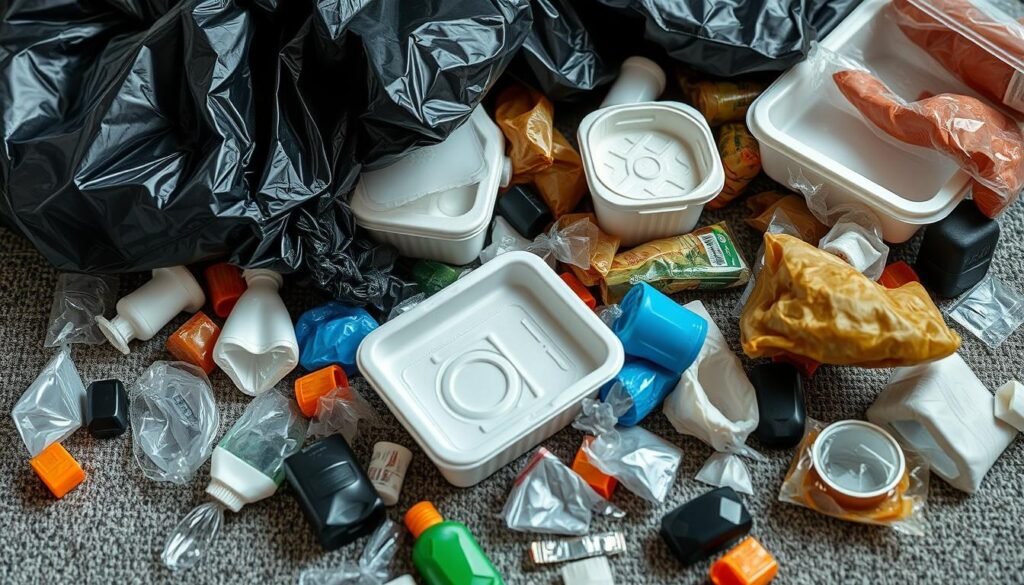
Plastic items for hygiene and medical use are non-recyclable too8. Think diapers, syringes, gloves, and tubing. They have harmful substances in them. Small plastic items like medicine bottles also pose problems. They’re made from low-value materials and can contain drug leftovers8. Plastic straws are another example. They’re often dirty and made from materials that aren’t valuable8.
Moreover, foam used in packaging and disposable cups from fast-food places can’t be recycled8. They have food residue and are made from plastics that don’t have much value.
Knowing about these types of plastics helps us sort our trash better. It shows why we need to use less non-recyclable plastics.
Step-by-Step Process of Plastic Recycling
Plastic recycling is key to waste management and environmental care. We’ll take you through its main phases: Collection, Sorting, and Reprocessing. Understanding these steps shows us the transformation from waste to something new.
Collection
During collection, plastics come from places like community bins and local drop-offs. Curbside pickups also play a part. This stage makes sure there’s enough material for recycling. It also helps create jobs which benefits both businesses and the environment9.
Sorting
Sorting plastics is important. At recovery facilities, workers and machines like optic sorters divide plastics. They categorize by color and type9. This careful sorting gets rid of unwanted materials. It makes sure the recycling is of high quality.
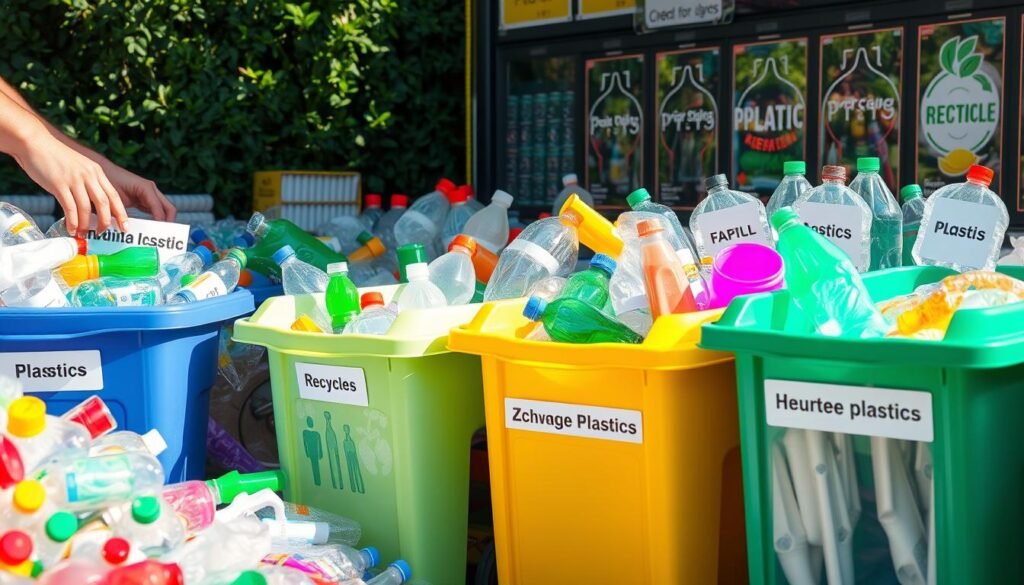
Reprocessing
The next step is reprocessing the plastics. They are first cleaned to remove any dirt. Shredders then turn the plastic into small flakes9. These flakes are cleaned again to take out metals and other bits. Finally, they’re melted down and reshaped into new products. This process handles many kinds of plastics, like PET and HDPE, among others10.
Want to know more about recycling plastics and how to keep our planet green? Check out our detailed guide at jiantaimachine.com9.
Recycling Symbols and Their Meaning
It’s really important to know what those recycling numbers mean. The number inside the recycling symbol tells you the type of plastic11. This helps you figure out which plastics are better for the environment. These numbers are called plastic identification codes. They let us know what kind of plastic an item is made of.
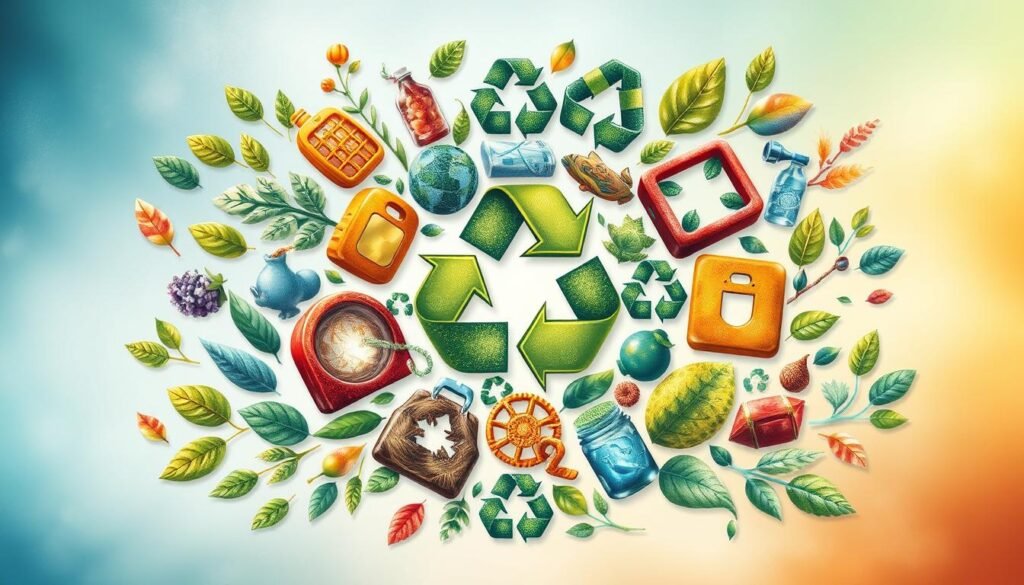
- PET or PETE (Symbol 1): Polyethylene terephthalate is used for drink bottles and water containers. It’s recycled about 20% of the time because it’s in high demand1213.
- HDPE (Symbol 2): High-density polyethylene is in cleaning product and milk containers. Most curbside recycling programs accept it1213.
- PVC or Vinyl (Symbol 3): You’ll find polyvinyl chloride in bubble wrap and food trays. It’s not often recycled, but some companies that make plastic wood will take it1213.
- LDPE (Symbol 4): Low-density polyethylene makes shopping bags. More recycling programs in the U.S. are starting to accept it1213.
- PP (Symbol 5): Polypropylene, found in furniture, toys, and medicine containers, is getting more accepted in recycling programs1213.
- PS (Symbol 6): Polystyrene is in toys and fridge trays but is hard to recycle. Some places won’t take it, especially if it’s foam1213. Some states have even banned it because it’s tricky to handle11.
- Other (Symbol 7): This includes different plastics like acrylic and fiberglass. They’re often not recycled and are usually burned1113. This is how we deal with these types of waste11.
To recycle well, we need to properly sort plastics by their resin codes. Always clean the items first to avoid contaminating the recycling process12. This keeps the recycling system working well.
| Symbol | Material | Common Uses | Recyclability |
|---|---|---|---|
| 1 (PET) | Polyethylene terephthalate | Soft drink bottles, mineral water containers | Moderate (20%)1213 |
| 2 (HDPE) | High-density polyethylene | Cleaning agents containers, milk jugs | High1213 |
| 3 (PVC) | Polyvinyl chloride | Bubble foils, trays for sweets | Low1213 |
| 4 (LDPE) | Low-density polyethylene | Shopping bags, crushed bottles | Increasing1213 |
| 5 (PP) | Polypropylene | Furniture, toys, medicine bottles | Increasing1213 |
| 6 (PS) | Polystyrene | Toys, refrigerator trays | Low1213 |
| 7 (Other) | Various plastics | Acrylic, polycarbonate, fiberglass | Low1113 |
How Can You Recycle Plastic at Home?
Recycling plastic at home helps us cut down on plastic waste in landfills and oceans. It’s important to follow the right steps to make this process work well. By using home recycling tips, we help keep our environment clean.
Preparing Plastic for Recycling
To recycle plastics, start by cleaning them well. Food or drink containers should be rinsed out to upgrade the recycling quality14. Remove labels and residues to get items ready for their next life.
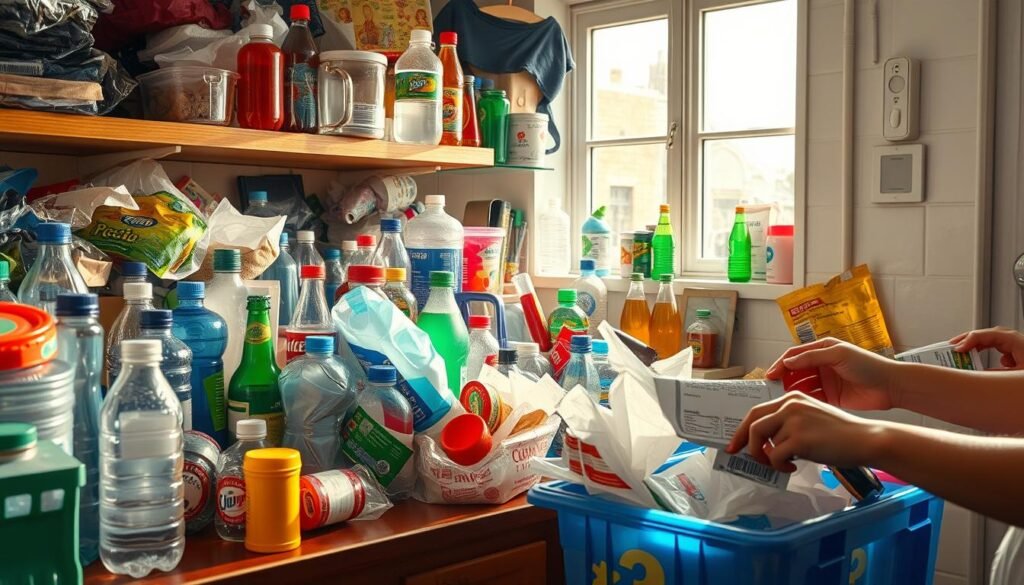
At home, sort plastics by looking at the resin identification codes. Understanding these codes helps sort effectively, making recycling better14.
Identifying and Sorting Plastics
Recognizing recyclable plastics like PET and HDPE is key. PET is found in bottles and containers and is commonly recycled15. HDPE is in milk jugs and shampoo bottles and is also accepted15. Setting up a system at home for sorting is essential for recycling success14.
Having our own recycling system at home boosts sustainability. This, along with knowing how to prepare and sort plastics, helps the environment. You can learn more about sustainable practices from this guide on recycling polypropylene plastic16.
Local Recycling Programs and Their Regulations
Understanding local recycling rules is key to managing waste well. Places like Hillsborough County and the City of Philadelphia have clear rules that help with recycling.
Checking Local Guidelines
In Hillsborough County, up to 80% of trash can be recycled. This shows how following local rules is vital for reducing waste17. Both renters and people in apartments can recycle easily. They don’t need a tax bill to participate17.
Philadelphia recycles plastics marked #1, #2, and #518. They also recycle metal cans and clean glass bottles18. But, things like plastic bags and food-stained items should not be in the recycling bin. They can harm the recycling process18.
Special Facilities for Hard-to-Recycle Plastics
Philadelphia offers places to recycle difficult plastics, beyond regular recycling. They have six centers where people can bring recyclables18. Hillsborough also has neat programs like art contests and compost workshops. These programs teach people how to manage waste better17.
Using these services helps communities lessen waste and improve recycling. Knowing and taking part in these special programs helps our environment.
Innovative Recycling Methods
We are stepping up in the world of recycling with new, smart methods. These advanced methods boost how well and effectively we recycle plastics. By adding hi-tech solutions to recycling, we make sure we separate materials better and get the most out of them.
Optic Sorting Machines
Optic sorting machines are a big step forward in sorting plastics. They use special sensors to quickly tell different types of plastic apart. This makes sorting more efficient and accurate. With the power of Artificial Intelligence, these machines cut down on mistakes and make recycling streams cleaner19. They are a key part of today’s recycling centers, helping to reduce waste and use resources wisely.
Sink-Float Separation
Sink-float separation is another cutting-edge way to sort plastics. It uses a tank of water to separate plastics by density. Heavier plastics sink and lighter ones float. This makes it easy to get the right materials out. It’s great for getting HDPE and PP plastics from mixed waste20. It’s simple, effective, and more places are starting to use it for cleaner recycling.
These new recycling methods are changing the game. They’re making recycling more effective and better for the planet. As more places start using these technologies, our dream of a sustainable future gets closer.
Tips for Reducing Plastic Waste
Reducing plastic use is very important. Global plastic production jumped from 2.3 million tons in 1950 to 448 million tons by 2015. It might even double by 2030 and nearly triple by 205021. By adopting eco-friendly habits, we can tackle this issue.
Starting with a home inventory of plastic is a great step. This lets us see and cut down on single-use plastics, which make up over 40% of plastic waste21. Saying no to things like plastic bags, straws, and forks really helps our planet21.
Another good move is choosing products that don’t come in plastic. About 80% of the plastic that ends up in the sea starts on land22. Opting for items like glass bottles or metal straws reduces our plastic use.
It’s also crucial to recycle smartly. Know which plastics your area recycles. Often, plastics marked with #1, #2, and #5 are accepted22. To be eco-friendly, make sure to clean items before recycling.
Pushing for better recycling policies and packaging also brings change. Currently, less than 9% of all plastics get recycled21. By spreading awareness, we can encourage more sustainable practices.
Remember, plastic pollution in the ocean almost can’t be reversed because it breaks down so slowly22. Even small actions can make a big difference. For example, choosing milk delivery services has become popular in the UK23.
Taking part in community projects and staying up-to-date with recycling can increase our impact. The U.S. only recycled about 6% of plastics in 202122, showing the need for us to work together. By following and sharing these tips, we can achieve better environmental health.
For more ideas on how to reduce plastic waste and understand its effects, check out this guide on the NPR website22.
Conclusion
Our guide on recycling plastic has shown how crucial this process is for our planet and health. We learned about the importance of understanding plastics, like High-Density Polyethylene (HDPE). HDPE is strong and can be recycled, helping to lessen our environmental footprint. Industry leaders like Jiantai Machine offer insights on properly recycling HDPE. For more information, check out this page.
Recycling helps reduce waste, but it faces challenges. Problems like contamination can worsen the quality of recycled plastics. Also, recycling can increase greenhouse gas emissions24. Still, there’s hope. New sorting technologies and chemical recycling methods are promising24. The world urgently needs to expand its recycling abilities. With plastic production and waste rising, efforts must grow too. The OECD warns that plastic waste might triple by 20601.
It’s vital for communities to get involved in recycling. Following local rules and joining recycling efforts can make a big difference. In 2007, the EU saw 24.6 million tonnes of plastic waste. Meanwhile, each person produced about 520 kg of trash a year25. By working together and embracing new ideas, we can push for a circular economy. This will lead to a greener future for all.


